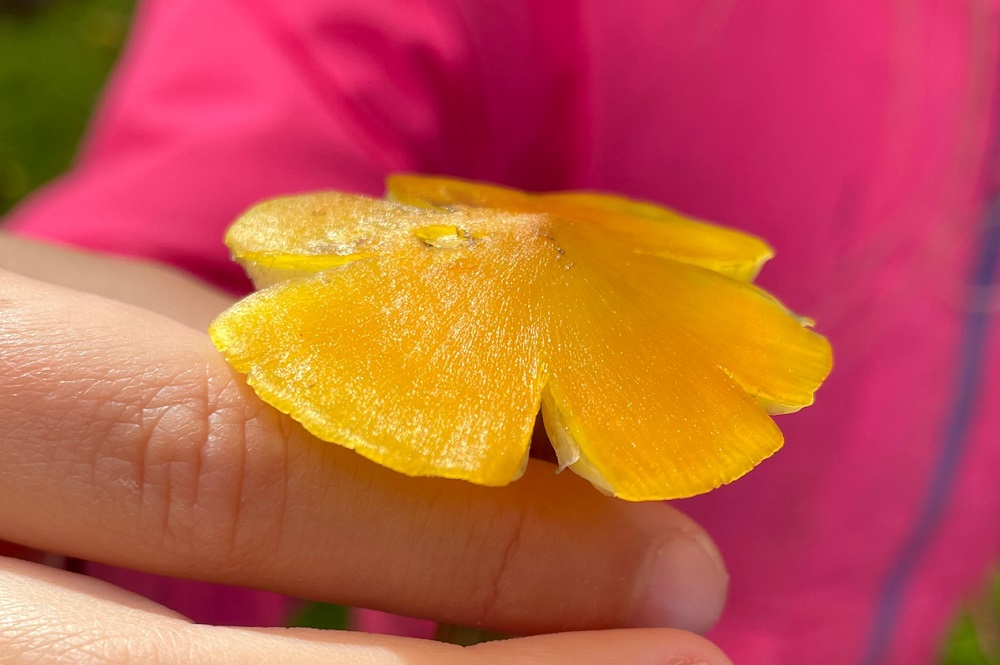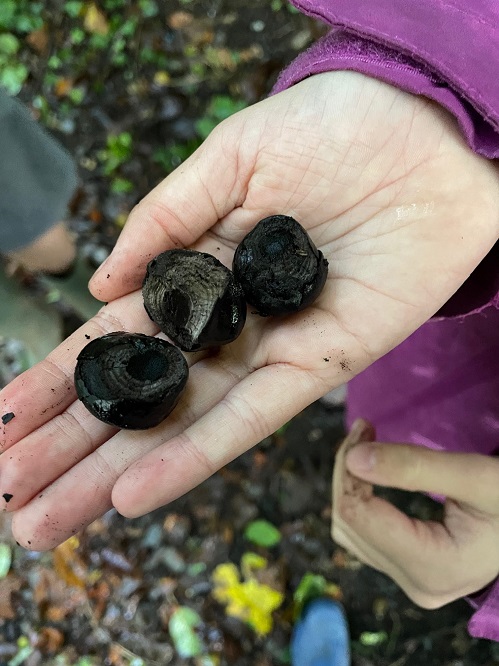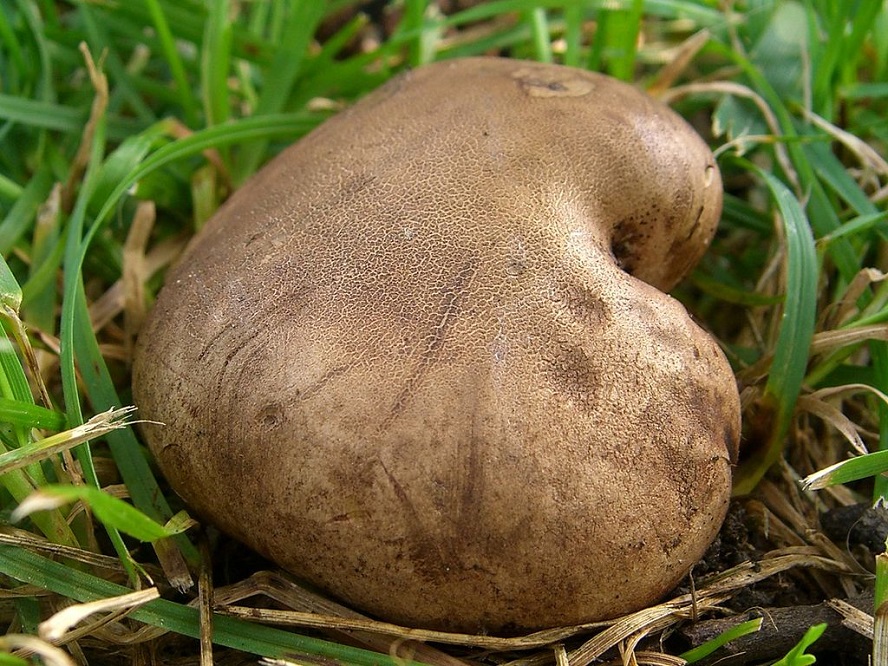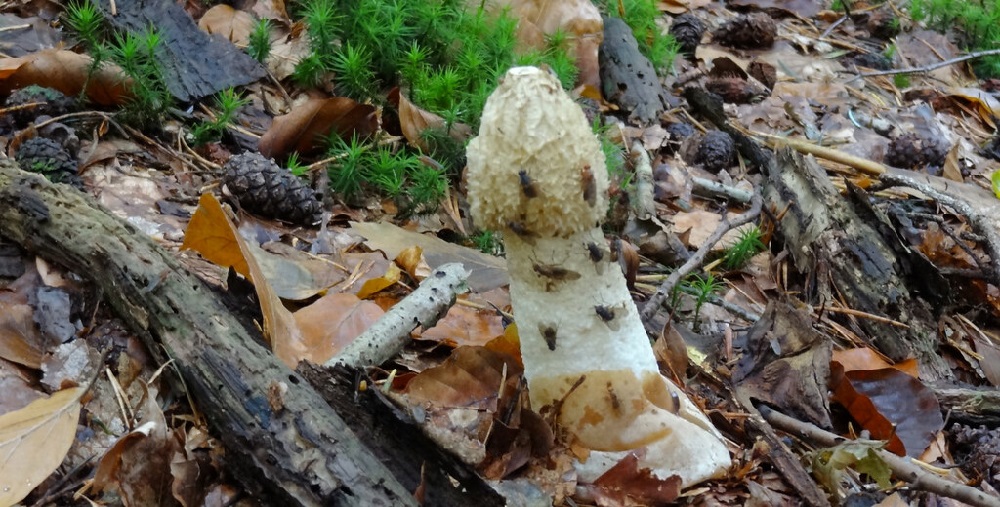Fruits of the Forest: Tawny Clark visits Clyne Valley woods to enjoy its spectacular array of wild fungi

Tawny Clark
The full family contingent is kitted out in waterproofs and wellies as we join the excited throng of intrepid woodland explorers. We’re all here to celebrate UK Fungus Day with an adventure through Clyne Valley woods, on the outskirts of Swansea, with Kenfig National Nature Reserve Warden, and local fun-guy, Chris Jones.
It’s autumn, when much of nature is settling down. Trees are tired. As they sigh off their heavy summer burdens, forest floors are littered with seed and a rainbow-dipped confetti of swirling leaves. Creatures are laying down fat stores before hibernation. Some are already hopping, scurrying and slithering into their frost-free hide-outs, or flying away to overwinter in warmer climes.
Squirrels are still busy creating a mess and a racket as they plunder through leaves, to hastily stash nuts and acorns; many of which will invariably lay forgotten and burst forth next spring. Us humans are in such a rush to plant new trees it seems we have forgotten nature’s role in nature.
The culinary and medicinal uses of fungi alone make them perhaps one of the most readily recognised living organisms on the planet. But how well do we really know fungi? For starters, did you know that they’re neither a plant nor animal, and instead have their own kingdom? One thing is for certain, when I set out in the downpour this morning, I didn’t expect to encounter tigers, leopards or royal legends hiding among the trees.
The romantic idyll of skipping through autumnal glades, swinging a hand-woven wicker collecting basket, is often associated with fungal forages. But with many of the 15,000 or so species of fungi in the UK being only distinguishable from one another under a microscope, picking wild fungi for consumption can be a rather precarious pastime. Unless you know what you’re doing, then the difference between edible and delicious and poisonous and deadly can be rather a perilous line to tread.
We have over a billion years of evolution to thank for what is without doubt the most fascinating, disparate and mind-boggling living realm it’s possible to delve into.
But, despite their baffling complexity, it’s an incredibly easy journey to begin. Fungi are quite literally everywhere.
Autumn is a season of mystery and folklore. The nights draw in. As we remember the dead, another secret, invisible world comes to life. This is fungi’s time to shine. The hugely diverse and utterly spectacular array of wild fungi is fruiting now, right under, and over, our noses.
Like an iceberg, the main body of fungi, the mycelium, lies beneath the surface. The thread-like hyphae, which resemble white strands of cotton-grass, branch out like tree roots, in search of water and nutrients. It’s merely the fruiting bodies we see bursting forth like slow-motion popcorn or springing into spongy parasols from trees, grasslands, fallen logs and leaf litter.
Our first stop this morning is a non-descript patch of grass on a residential street, where we find waxcaps. Highly sensitive to fertiliser, waxcaps are a good indicator of healthy soil. They can take an incredible sixty years to appear. Snowy waxcap Cuphophyllus virgineus, Blackening waxcap Hygrocybe conica, and Fibrous waxcap Hygrocybe intermedia, have all been identified along this unassuming, closely mown verge which many of us would most likely walk past obliviously.

We enter the wood and find King Alfred’s cakes. These black, conker-sized, fungal growths form on fallen ash trees, and are also known as Cramp balls or Coal fungus. This wart-like species has a regal history. The legend goes that King Alfred, upon seeking refuge in the home of a peasant, was left to watch over her cakes, and inadvertently burnt them. One version tells that he tried to hide the evidence in the forest – and here they remain.
Inside this firm, kidney-shaped fungi we find a monochrome rainbow, formed by the concentric bands which supply its Latin name, Daldinia concentrica. This fungus was historically used to transport fire embers, and likely still can, although caution and common sense is of course advised.
I discover that the puffballs I was already familiar with, might well be earthballs – which I’d never heard of. Skin thickness is key to differentiating the two. It seems a handy folding knife is an essential piece of kit for a budding Mycologist, as a specimen is carefully cut in half by or expert guide.
Resembling a potato, it has a thick, firm skin and is somewhat fig-like within. Both puffballs and earthballs are packed with spores which billow in a theatrical puff of smoke when disturbed, so it’s sensible to keep your mouth closed if you try this.
They’re common, but Chris tells us there’s a rare weevil that feeds on the Leopard earthball, Scleroderma areolatum, which has been identified here, so we won’t overdo our puffball or earthball investigation for further finds.

The common names for many species of fungi are delightfully and terrifyingly self-explanatory. Poisonous varieties like the Destroying angel, Funeral bell and Death cap leave little to the imagination (although we don’t find any of those today). A quick image search reveals some rather innocuous mushrooms; worryingly similar in appearance to our edible supermarket varieties.
One species with overtly delectable appeal is the Beefsteak fungi, Fistulina hepatica. As its name suggests, it’s a melt-in-the-mouth medium rare steak when sliced, and I’m salivating at the sight of it. I’m warned off having a nibble, due to its strongly acid and bitter taste. Unpalatable rather than poisonous.
For those who don’t appreciate the intrinsic value of nature, the beefsteak has a commercial value too. Its mycelium can reach deep into the inner core of the oak on which it grows, into the very heartwood of these majestic giants of the forest. The fungus causes the heart to grow richer and darker in colour. Known as spalted wood, the host tree can transform into a woodcutter’s treasure, the much-prized Tiger oak.
On beech branches high over the forest floor we find angelic-looking, Porcelain fungi, Oudemansiella mucida. From below, they appear translucent in the pockets of sunshine that dapple the day’s greyness. Tiny gills or lamella, support their delicate caps, which spread like fairy tutus along the arms of the overhanging canopy.
A brittle, roan-coloured holly leaf is held aloft by an enthusiastic member of our party, which has spread out over the undulating, cool mustiness of the decaying forest in search of fungal curiosities. The black flecked fungus which has replaced the glistening sheen of this festive centrepiece, is aptly named Holly speckle, Trochila ilicina.
Microscopic
A member of the Carmarthenshire Fungus Group who’s also joined us today, delights at finding an almost microscopic, Holly parachute mushroom Marasmius hudsonii. It’s hard to imagine a cuter mushroom. This rare, miniscule fungus only grows on second year fallen holly leaves, so to uncover one requires a delicate hand to clear aside the current year’s layer of leaves; along with a very keen eye. It’s quite a find.
Easier to spot is the magnificent Artist’s palette, Ganoderma applanatum. It’s a vast, bracket fungus, so named for its calico underside which can be scratched, or ‘drawn’ upon with a sharp tool, or even a fingernail.
We’re shown another bracket fungus, the Birch polypore, Fomitopsis betulina, long used in medicine due to its antibacterial properties. Chris peels some skin from its cap to demonstrate its use as a natural plaster. Historically, I’m told, it was also used to strop razors.
On a fallen log, Chris points to a bizarre collection of thin, black, finger-like protrusions. These are Dead moll’s fingers Xylaria longipes, and, like the similar Dead man’s fingers Xylaria polymorpha, they have the disturbing and chilling appearance of someone reaching out from beneath the ground.

Sadly, we don’t find my favourite fungus, the Stinkhorn, or Witch’s egg, Phallus impudicus. This phallus shaped fungus is well-named. Despite not getting to see one in the flesh today, when we gather back at the entrance to the wood, I’m ‘rewarded’ instead with the opportunity to sniff a sealed container that previously held one.
The Stinkhorn emits an odour of rotting meat to attracts flies, which help to spread its spores. The waft I get from the tub is more overripe Camembert, or cheesy feet. And with that, it’s time for lunch.
Support our Nation today
For the price of a cup of coffee a month you can help us create an independent, not-for-profit, national news service for the people of Wales, by the people of Wales.





